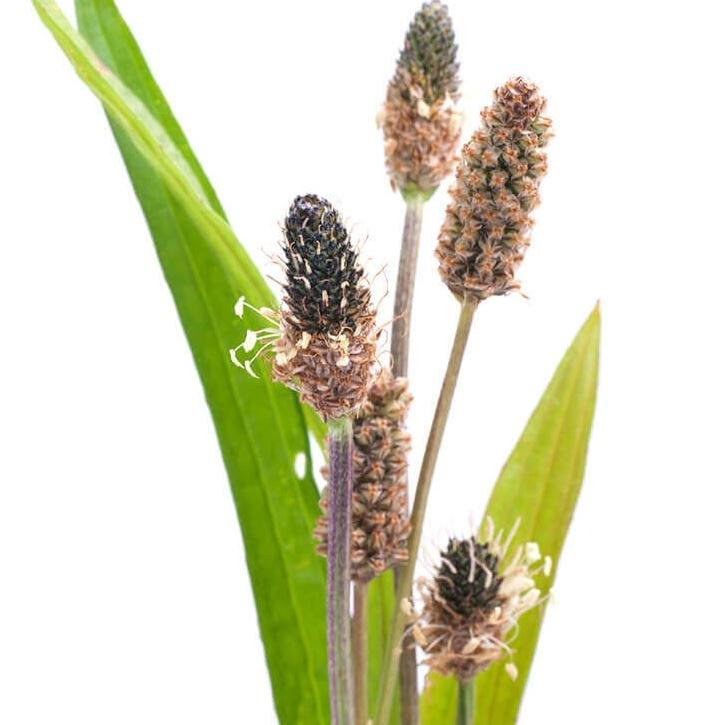Description
It’s a vivacious, perennial herbaceous plant of 10 to 60 cm in height, acaulescent (with no visible stem and all leaves at the base forming a basal rosette). Leaves are long and narrow, originated at ground level directly from the root and grow vertically forming a basal rosette, lanceolate oblong and sharp at the apex. They are, generally, pale green or grayish-green, hairless or slightly pilose, connected to the stem by a short, thin petiole. In the lower face the limb stands out with 5 to 6 whitish-green nerves displayed almost in a parallel way and are clearly noted on the back. From the same point the leaves start, the floral peduncles start, too. These peduncles are covered, on their upper half, by plenty of small flowers without any petiole, forming condensed spikes, cylindrical, on scapes, with oval-shaped, lanceolate bracts and acuminate scarious margins, glabrous or slightly pubescent, white or purple, small, grouped with blond petals. Flowers take place at the upper part of the peduncle. They are hermaphrodite, actinomorphic, tetrameric. The fruit is a small capsule that when it ripens, the seedpods split in half, and the seeds fall to the ground. It belongs to the Plantaginaceae family.It is spread along Europe and northern and central Asia. found in gardens and lawns, along trails, in sidewalk cracks, and in similar habitats. It blooms in late spring early autumn. Tender and fresh leaves are edible and make great salads.
Part used
Aerial parts.
Indications
Internal use
- Respiratory tract disorders: cold, flu, bronchitis, asthma, irritating cough, allergic rhinitis, hay fever, allergies, allergic sinusitis, pharyngitis, etc.
- Inflammatory disorders of buccopharyngeal mucosa, gastritis, gastroduodenal ulcer, hyperacidity, diarrhea.
- Other: hemorrhages, hemorrhoids, gastrointestinal pain, rheumatism, cystitis and urethritis.
External use
- Skin inflammatory disorders: eczema, herpes, fissures, furuncles, chafing, wounds.
- Eye disorders: blepharitis (eyelids inflammation), conjunctivitis.
- Mouth disorders: stomatitis (buccal mucosa inflammation), gingivitis (gums inflammation), glossitis (tongue inflammation).
Bibliography
- Real Farmacopea Española, Suplemento 1999.
- Real Farmacopea Española, Suplemento 2001.
- Pharmacopée Française IX Édition.
- Plantas Medicinales. Thérapeutique-Toxicité. Christiane Vigneau. Masson, Paris 1985.
- Herbal Drugs and Phytopharmaceuticals. Norman Grainger Bisset (Ed). Max Wichtl. CRC Press.1994.
- Plantas Medicinales y Drogas Vegetales para infusión y tisana. Edición española a cargo de: Salvador Cañogueral, Roser Vila, Max Wichtl.1998.
- Matière Médicale. RR Paris- H. Moyse. Masson 1981.
- The Complete German Commission E Monographs. Therapeutic Guide To Herbal Medicines. Mark Blumenthal. American Botanical Council 1998.
- Fitoterapia Aplicada. J.B. Peris, G. Stübing, B.Vanaclocha. Colegio Oficial de Farmacéuticos de Valencia 1995.
- Fitoterapia: Vademecum de Prescripción. Plantas Medicinales. Colaboran: Asociación española de médicos naturistas. Colegio Oficial de Farmacéuticos de Vizcaya.
- Plantas Medicinales. El Dioscórides Renovado. Pio Font Quer.
- Guía de Campo de las Flores de Europa. Oleg Polunin. Ediciones Omega S.A. Barcelona, 1977.
- Pharmacognosy 9th edition. Varro E. Tyler – Lynn R. Brady – James E. Robbers.
- Farmacognosia. G.E. Trease y W. C.Evans. CECSA.
- Plantas Medicinales. Margarita Fernandez y Ana Nieto. Ed Universidad de Navarra. EUNSA 1982.
- 100 Plantes Medicinales. Max Rombi. Romart 1998.
- Pharmacognosy, Phytochemistry, Medicinal Plants. Jean Bruneton. Lavoisier Publishing.
- Enciclopedia de las Hierbas Medicinales. Tina Cecchini. Ed. de Vecchi S.A. 1995.
- Pharmacognosy, Phytochemistry, Medicinal Plants. Jean Bruneton. Lavoisier Publishing.
- The Complete German Commission E Monographs. Therapeutic Guide To Herbal Medicines. Mark Blumenthal. American Botanical Council 1998.
